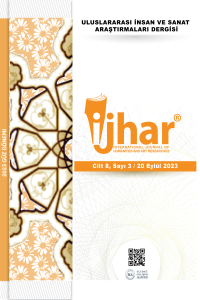Öz
Al-Andalus, with its Islamic roots, was influenced by three main basins during the establishment period and experienced a
new transformation and change with each basin. The influence of Damascus comes first among these major changes that
follow each other chronologically. It seems to be a natural and inevitable process that Al-Andalus, which became a
governorship affiliated to the Damascus Umayyad Caliphate since the conquest, was predominantly under the influence of
Damascus in its first years. On the other hand, in this period, Al-Andalus was officially subordinate to Damascus, but de
facto subordinate to the governorship of North Africa. For this reason, from the first years, North Africa and thirdly Egypt
have always had an influence on Al-Andalus.
To understand the emergence of any civilization well and correctly, it is generally referred to the foundation period. In this
study, it is aimed to deal with the establishment of the Andalusian civilization by going down to its roots. Among these
roots, Hejaz, Egypt, and North Africa come first. Later, Iraq and especially Baghdad form the main roots of Andalusian
civilization. On the other hand, Europe and the Mediterranean are among the roots of this new civilization. In particular,
South-Western Europe and the Western Mediterranean are the main roots. The part up to this point constitutes the
geographical roots of the Andalusian civilization. Parallel to these, there are also historical roots. The Umayyads in the east
and the Roman and Visigoth dominations in the west constitute the most important roots of Al-Andalus.
Looking at their political roots, Fatimids, Almoravids and Almohads, besides the Abbasids, each shaped or somehow
influenced the political structure of Al-Andalus as Islamic states belonging to different geographies. On the other hand,
Byzantium, France, Normandy, and the Spanish kingdoms in the North (Castil, Neon, Aragon, Navarra) have been on the
main agenda of Andalusian political life for centuries. On the other hand, different ethnic elements take place in the
formation of the new civilization, which creates ethnic roots. Al-Andalus consists mainly of Arabs, Berbers, Slavs, and
Spaniards. These peoples formed a common culture, the Andalusian culture, together as Muslims, Christians, and Jews,
without assimilation with their different religious identities and without experiencing any assimilation pressure.
There are certain cities that have been the source of the formation of Andalusian culture and have been the main hearths
of science and culture in Al-Andalus. Kayravan was the first stop of the Andalusians as one of the first Islamic cities
established in North Africa. Later, Alexandria attracted the attention of Andalusians with its important scholars and
madrasahs. Mecca and Medina were the main sources of science and culture in Al-Andalus. In the following years, the
interaction of Al-Andalus with Baghdad and other Islamic cities gradually increased.
Al-Andalus is one of the best examples of not only living together, but also creating a common culture and civilization
together. The harmony and solidarity that the Arab peoples, the founding elements of Islamic civilization, and the newly
converted Berber and Spanish peoples in the Iberian Peninsula showed during and after the conquest, went down in history
as an experience unique to these lands. Contrary to the oppression and coercion that the Jewish community has been
subjected to since the Roman period in Iberia, it is also one of the privileges of this civilization that it has become a part of
Andalusian culture freely and wholeheartedly. Jewish scholars in Al-Andalus, speaking and writing in Arabic, became an
integral part of this culture. Great philosophers such as Ibn Dawud and Maimonides, poets such as Ibn Ezra and Kasmune
bint Ismail, and great statesmen such as Hasdai bin Shaprut were very influential in Al-Andalus. Christians, too, quickly
adapted to the Andalusian culture and created a literature written in Spanish with the Arabic alphabet called Aljamiedo.
The capital Kurtuba hosted Christian students from European cities -individually or in groups- and these students became
the main representatives of Islamic culture and science in their own countries.
Anahtar Kelimeler
Kaynakça
- Bişrî (1997). el-Hayâtü’l-ilmiyye fî asri’l-hilâfeti fi’l-Endelüs. Mekke: Ma’hedü’l-Buûsü’l-İlmiyye ve İhyâü’t-Türâsi’l-İslâmî.
- Castiglioni, A (1960). The Contribution of The Jews to Medicine. The Jews: Their history, culture and religion, (Ed. Louis Finkelstein), Volume 1, New York: Harper and Brother Publishers.
- Dabbî (1967). Buğyetü’l-mültemis fi ricâli ehli’l-Endelüs. Dâru’l-Kâtib.
- Haines, CR (1889). Christianity and Islam in Spain A.D. 756-1031, London: Kegan Paul, Trench & Co.
- Hemedânî, H (1999). Câmiatü Kurtuba: dirâsetün li-nizâmiha’t-ta’lîmî ve eseriha’l-hadârî hattâ nihâyeti’l-karni’l-hâmisi’l-hicrî. İslamabad: ed-Dirasatü’l-İslâmiyye.
- Irwing, T (1992). Andalusia. Tustin: Council of Islamic Education.
- İbn Abdilhakem (1858). Zikru fethi’l-Endelüs. (Ed. John Harris Jones). London: Wiliiams & Norgate. İbn Haldun (1971). Kitâbü’l-iber ve dîvânü’l-mübtedei ve’l-haber IV. Beyrut: Müessesetü’l-A’lâ li’l-Matbûât.
- İbn Hayyan (1973). el-Muktebes min enbâi ehli’l-Endelüs. (Tahkik: Mahmûd Ali Mekkî), Beyrut: Dâru’l-Kitâbi’l-Arabî.
- İbn Saîd (1980). el-Muğrib fî hule’l-mağrib I-II. (Üçüncü Baskı), (Tahkik: Şevki Dayf). Kâhire: Dâru’l-Meârif. İbnü’l-Cevzî (1992). el-Muntazam fî târîhi’l-ümem ve’l-mülûk VI. Beyrut: Dâru’l-Kütübi’l-İlmiyye.
- İbnü’l-Esîr (1965). el-Kâmil fi’t-târîh IV. Beyrut: Dâru Sâdır.
- Kehhâle, ÖR (1974). Mukaddemât ve mebâhis fî hadârati’l-Arab ve’l-İslâm. Dımeşk: Matbaatü’l-Hicaz.
- Kurt A (1997). Mağrib ve Endülüs’te hadis ilminin gelişim safhaları ve Muhyiddin İbnü’l-Arabî’nin hadis kültürü. (Yayımlanmamış doktora tezi). Ankara Üniversitesi Sosyal Bilimler Enstitüsü, Ankara.
- Lapidus, IM (2003). İslam toplumları tarihi. (çev. Yasin Aktay). İstanbul: İletişim Yayınları.
- Merrâküşî (1963). el-Mu’cib fî telhîsi ahbâri’l-Mağrib. (Tahkik: Muhammed Saîd el-Uryân). Kâhire: el-Meclisü’l-A’lâ li’ş-Şuûni’l-İslâmiyye.
- Münîre, A (2002) Ulemâü’l-Endelüs fi’l-karneyni’r-râbi’ ve’l-hâmis el-hicriyyeyni. Riyad. Mektebetü’k-Melik Fahd el-Vataniyye.
- Provençal, EL (1957). Instituciones y Vida Social e Intellectual. Historia de Espanya V. (Ed. Ramon Menendez Pidal). Madrid: Espasa Calpe.
- Roth, C (1960). The European Age in Jewish History. The Jews: Their history, culture, and religion, (Ed. Louis Finkelstein), New York: Harper and Brother Publishers, 1:216-217.
- Ruster, J (1998). The Muslim Civilization and Its Tolerance of Christianity in Tenth Century Cordoba. Iberia and its affects on Christianity in Leon, Christian Iberia, California: California State University Press.
- Samerrâî H, Abdülvâhid Z, Nâtık S (2000). Târihu’l-Arab ve hadâratühüm fi’l-Endelüs. Beyrut: Dâru’l-Kitâbi’l-Cedîdi’l-Müttahide.
- Sezgin, (2004). İslam kültür dünyasının bilimler tarihindeki yeri. Ankara: TÜBA.
- Taberî (ty). Târîhu’l-ümem ve’l-mülûk VI. Beyrut: Dâru Süveydân.
- Wright, O (1992). Music in Muslim Spain. The legacy of Muslim Spain. Leiden: Brill, II:555-582.
- Yıldız, Ş (2008). Kurtuba: VIII.-XIII. yüzyıllar. (Yayımlanmamış doktora tezi). Bursa Uludağ Üniversitesi Sosyal Bilimler Enstitüsü, Bursa.
- Yıldız, Ş (2022). İslam şehrinin temel özellikleri. Hz. Peygamber ve Şehir, İstanbul: Nefes Yayınevi, 7-33.
- Yıldız, Ş (2023). Orta çağ Avrupa’sını aydınlatan İslam kandili: Kurtuba. Derin Tarih, 24, 135-145.
- Yıldız. Ş (2009). Endülüs Yahudileri ve İslam kültür ve biliminin Avrupa’ya geçişinde oynadıkları rol. İstem, 7(13), 51-68.
Öz
Herhangi bir medeniyetin ortaya çıkışını iyi ve doğru anlayabilmek için genellikle kuruluş dönemine gidilir. Bu çalışmada da
Endülüs medeniyetinin kuruluşunu köklerine inerek ele almak hedeflenmiştir. Bu kökler arasında Hicaz, Mısır, Kuzey Afrika
başta gelir. Daha sonra Irak ve özellikle de Bağdat Endülüs medeniyetinin ana köklerini oluşturur. Diğer taraftan Avrupa ve
Akdeniz bu yeni medeniyetin kökleri arasındadır. Özellikle de Güney Batı Avrupa ile Batı Akdeniz ana kökler olarak yer
alırlar. Buraya kadar olan kısım Endülüs medeniyetinin coğrafi köklerini oluşturur. Bunlara paralel olarak bir de tarihi kökler
vardır. Doğuda Emeviler ile batıda Roma ve Vizigot hakimiyetleri Endülüs’ün en önemli köklerini oluştururlar.
Siyasi köklerine bakıldığında Abbasiler’in yanında Fatımiler, Murabıtlar ve Muvahhidler her biri farklı coğrafyaya ait İslam
devletleri olarak Endülüs’ün siyasi yapısını şekillendirmiş ya da bir şekilde etkilemişlerdir. Öte yandan Bizans, Fransa,
Normandiyalılar ve Kuzeydeki İspanyol krallıkları (Kastilya, Neon, Aragon, Navarra) da Endülüs siyasi yaşamının asırlarca ana
gündeminde olmuşlardır. Diğer taraftan yeni medeniyetin oluşumunda farklı etnik unsurlar yer alır ki bu da etnik kökleri
oluşturur. Endülüs temel olarak Arap, Berberî, Slav ve İspanyollardan oluşur. Bu halklar faklı dini kimlikleriyle asimile
olmadan ve herhangi bir asimilasyon baskısı da yaşamadan Müslüman, Hıristiyan ve Yahudi olarak birlikte ortak bir kültürü,
Endülüs kültürünü oluşturmuşlardır.
Belli başlı şehirler vardır ki Endülüs kültürünün oluşumuna kaynaklık etmiş ve Endülüs’teki ilim ve kültürün ana ocakları
olmuşlardır. Kayravan Kuzey Afrika’da kurulmuş ilk İslam şehirlerinden biri olarak Endülüslülerin ilk durağı olmuştur. Daha
sonra İskenderiye önemli ilim adamları ve medreseleriyle Endülüslülerin ilgisini çekmiştir. Mekke ve Medine ise Endülüs’ün
ilim ve kültürde ana kaynakları olmuşlardır. İleriki yıllarda Bağdat ve diğer İslam şehirleriyle Endülüs’ün etkileşimi gittikçe
artmıştır.
Endülüs medeniyetinin kuruluşunda etken olan coğrafî, siyasi, etnik, tarihi, dini ve kültürel etkenleri bir bütün olarak
görebilmek söz konusu köklerin her birisiyle ilintilidir. Bunlardan bir tanesinin eksik olması, ortaya çıkan tablonun
anlaşılmamasına ya da yanlış algılanmasına yol açacaktır. Bu nedenle hem doğuya ait olan hem de batıya ait olan köklerin iyi
bilinmesi gerekli gözükmektedir.
Anahtar Kelimeler
Kaynakça
- Bişrî (1997). el-Hayâtü’l-ilmiyye fî asri’l-hilâfeti fi’l-Endelüs. Mekke: Ma’hedü’l-Buûsü’l-İlmiyye ve İhyâü’t-Türâsi’l-İslâmî.
- Castiglioni, A (1960). The Contribution of The Jews to Medicine. The Jews: Their history, culture and religion, (Ed. Louis Finkelstein), Volume 1, New York: Harper and Brother Publishers.
- Dabbî (1967). Buğyetü’l-mültemis fi ricâli ehli’l-Endelüs. Dâru’l-Kâtib.
- Haines, CR (1889). Christianity and Islam in Spain A.D. 756-1031, London: Kegan Paul, Trench & Co.
- Hemedânî, H (1999). Câmiatü Kurtuba: dirâsetün li-nizâmiha’t-ta’lîmî ve eseriha’l-hadârî hattâ nihâyeti’l-karni’l-hâmisi’l-hicrî. İslamabad: ed-Dirasatü’l-İslâmiyye.
- Irwing, T (1992). Andalusia. Tustin: Council of Islamic Education.
- İbn Abdilhakem (1858). Zikru fethi’l-Endelüs. (Ed. John Harris Jones). London: Wiliiams & Norgate. İbn Haldun (1971). Kitâbü’l-iber ve dîvânü’l-mübtedei ve’l-haber IV. Beyrut: Müessesetü’l-A’lâ li’l-Matbûât.
- İbn Hayyan (1973). el-Muktebes min enbâi ehli’l-Endelüs. (Tahkik: Mahmûd Ali Mekkî), Beyrut: Dâru’l-Kitâbi’l-Arabî.
- İbn Saîd (1980). el-Muğrib fî hule’l-mağrib I-II. (Üçüncü Baskı), (Tahkik: Şevki Dayf). Kâhire: Dâru’l-Meârif. İbnü’l-Cevzî (1992). el-Muntazam fî târîhi’l-ümem ve’l-mülûk VI. Beyrut: Dâru’l-Kütübi’l-İlmiyye.
- İbnü’l-Esîr (1965). el-Kâmil fi’t-târîh IV. Beyrut: Dâru Sâdır.
- Kehhâle, ÖR (1974). Mukaddemât ve mebâhis fî hadârati’l-Arab ve’l-İslâm. Dımeşk: Matbaatü’l-Hicaz.
- Kurt A (1997). Mağrib ve Endülüs’te hadis ilminin gelişim safhaları ve Muhyiddin İbnü’l-Arabî’nin hadis kültürü. (Yayımlanmamış doktora tezi). Ankara Üniversitesi Sosyal Bilimler Enstitüsü, Ankara.
- Lapidus, IM (2003). İslam toplumları tarihi. (çev. Yasin Aktay). İstanbul: İletişim Yayınları.
- Merrâküşî (1963). el-Mu’cib fî telhîsi ahbâri’l-Mağrib. (Tahkik: Muhammed Saîd el-Uryân). Kâhire: el-Meclisü’l-A’lâ li’ş-Şuûni’l-İslâmiyye.
- Münîre, A (2002) Ulemâü’l-Endelüs fi’l-karneyni’r-râbi’ ve’l-hâmis el-hicriyyeyni. Riyad. Mektebetü’k-Melik Fahd el-Vataniyye.
- Provençal, EL (1957). Instituciones y Vida Social e Intellectual. Historia de Espanya V. (Ed. Ramon Menendez Pidal). Madrid: Espasa Calpe.
- Roth, C (1960). The European Age in Jewish History. The Jews: Their history, culture, and religion, (Ed. Louis Finkelstein), New York: Harper and Brother Publishers, 1:216-217.
- Ruster, J (1998). The Muslim Civilization and Its Tolerance of Christianity in Tenth Century Cordoba. Iberia and its affects on Christianity in Leon, Christian Iberia, California: California State University Press.
- Samerrâî H, Abdülvâhid Z, Nâtık S (2000). Târihu’l-Arab ve hadâratühüm fi’l-Endelüs. Beyrut: Dâru’l-Kitâbi’l-Cedîdi’l-Müttahide.
- Sezgin, (2004). İslam kültür dünyasının bilimler tarihindeki yeri. Ankara: TÜBA.
- Taberî (ty). Târîhu’l-ümem ve’l-mülûk VI. Beyrut: Dâru Süveydân.
- Wright, O (1992). Music in Muslim Spain. The legacy of Muslim Spain. Leiden: Brill, II:555-582.
- Yıldız, Ş (2008). Kurtuba: VIII.-XIII. yüzyıllar. (Yayımlanmamış doktora tezi). Bursa Uludağ Üniversitesi Sosyal Bilimler Enstitüsü, Bursa.
- Yıldız, Ş (2022). İslam şehrinin temel özellikleri. Hz. Peygamber ve Şehir, İstanbul: Nefes Yayınevi, 7-33.
- Yıldız, Ş (2023). Orta çağ Avrupa’sını aydınlatan İslam kandili: Kurtuba. Derin Tarih, 24, 135-145.
- Yıldız. Ş (2009). Endülüs Yahudileri ve İslam kültür ve biliminin Avrupa’ya geçişinde oynadıkları rol. İstem, 7(13), 51-68.
Ayrıntılar
| Birincil Dil | Türkçe |
|---|---|
| Konular | Çok Kültürlü ve Kültürlerarası Çalışmalar, Kültür, Temsil ve Kimlik, Kültürel çalışmalar (Diğer), İslam Sanatları |
| Bölüm | Araştırma Makaleleri |
| Yazarlar | |
| Erken Görünüm Tarihi | 17 Eylül 2023 |
| Yayımlanma Tarihi | 20 Eylül 2023 |
| Gönderilme Tarihi | 21 Ağustos 2023 |
| Kabul Tarihi | 7 Eylül 2023 |
| Yayımlandığı Sayı | Yıl 2023 Cilt: 8 Sayı: 3 |









